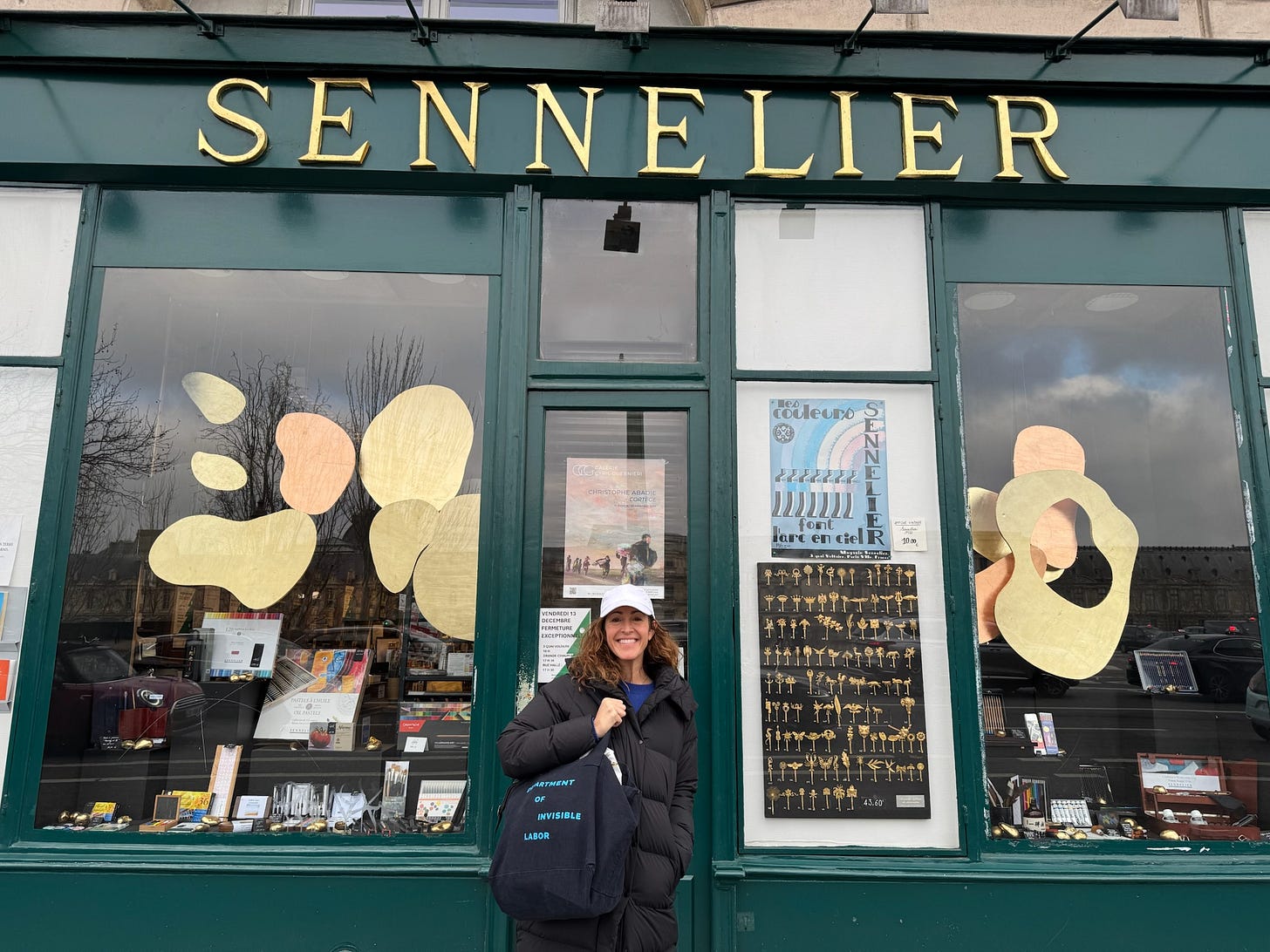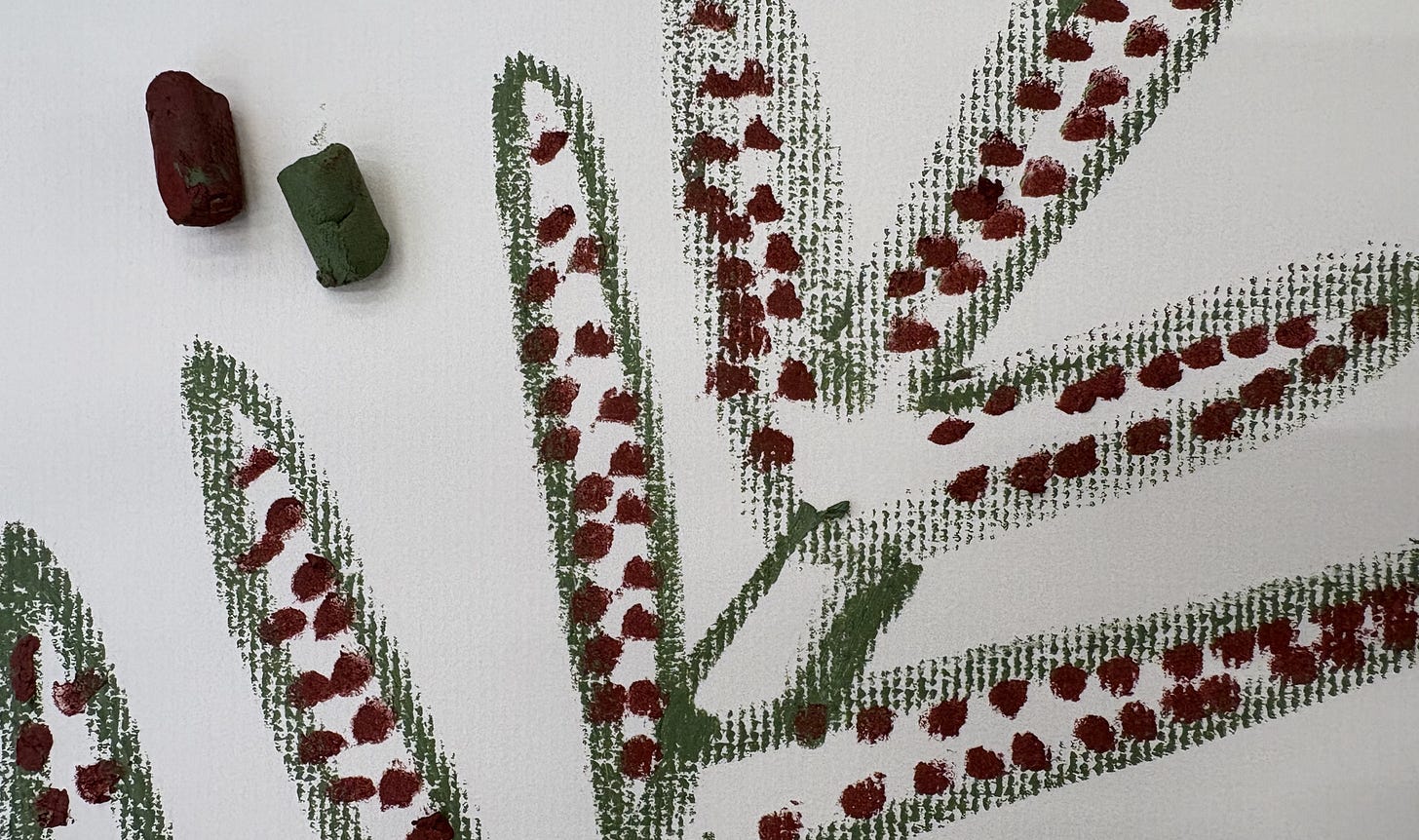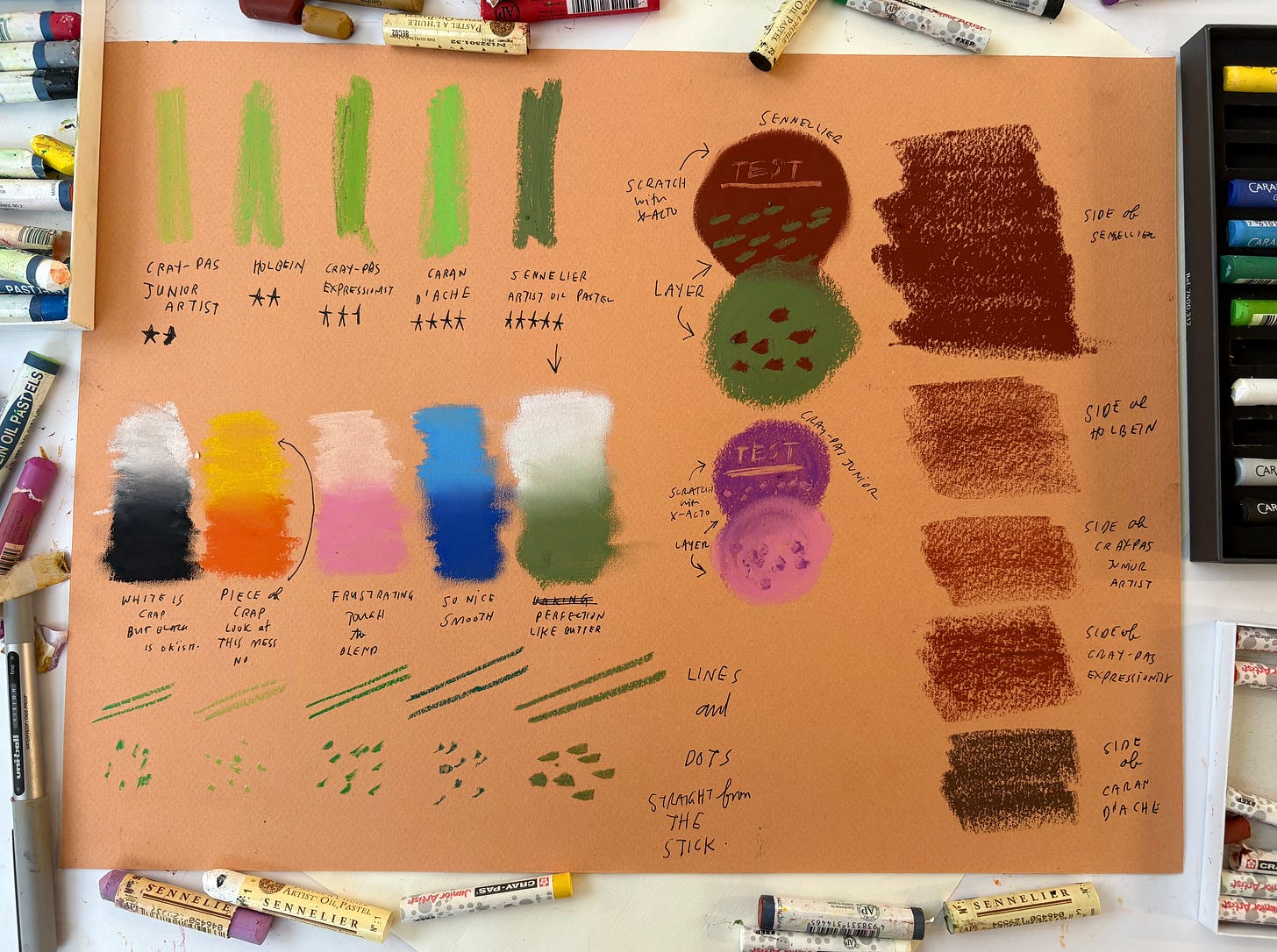Feeling Stressed? This Art Medium Will Boost Your Mood.
The most mood boosting art supply may surprise you...
Helllooooooo!
I’m so happy you’re here. Thanks for the outpouring of love around my recent surgery. I’m happy to share I’m healing well. I’m walking with a cane, which I think is pretty dapper. With a week like the last one in the US, we gotta take every smile we can get.
To wit, so many new folks have joined us at the Grown-Ups Table! Hello! Given it’s back-to-school, I thought that some new people may not know about DrawTogether Classrooms, the non-profit arm of DrawTogether that helps grow young people’s curiosity, confidence, care, and creativity through drawing. For new folks: DrawTogether Classrooms supports thousands of educators around the country (and the world!) to bring more art and social-emotional learning into learning environments with joyful, accessible interactive videos, podcasts, activities, and curriculum.
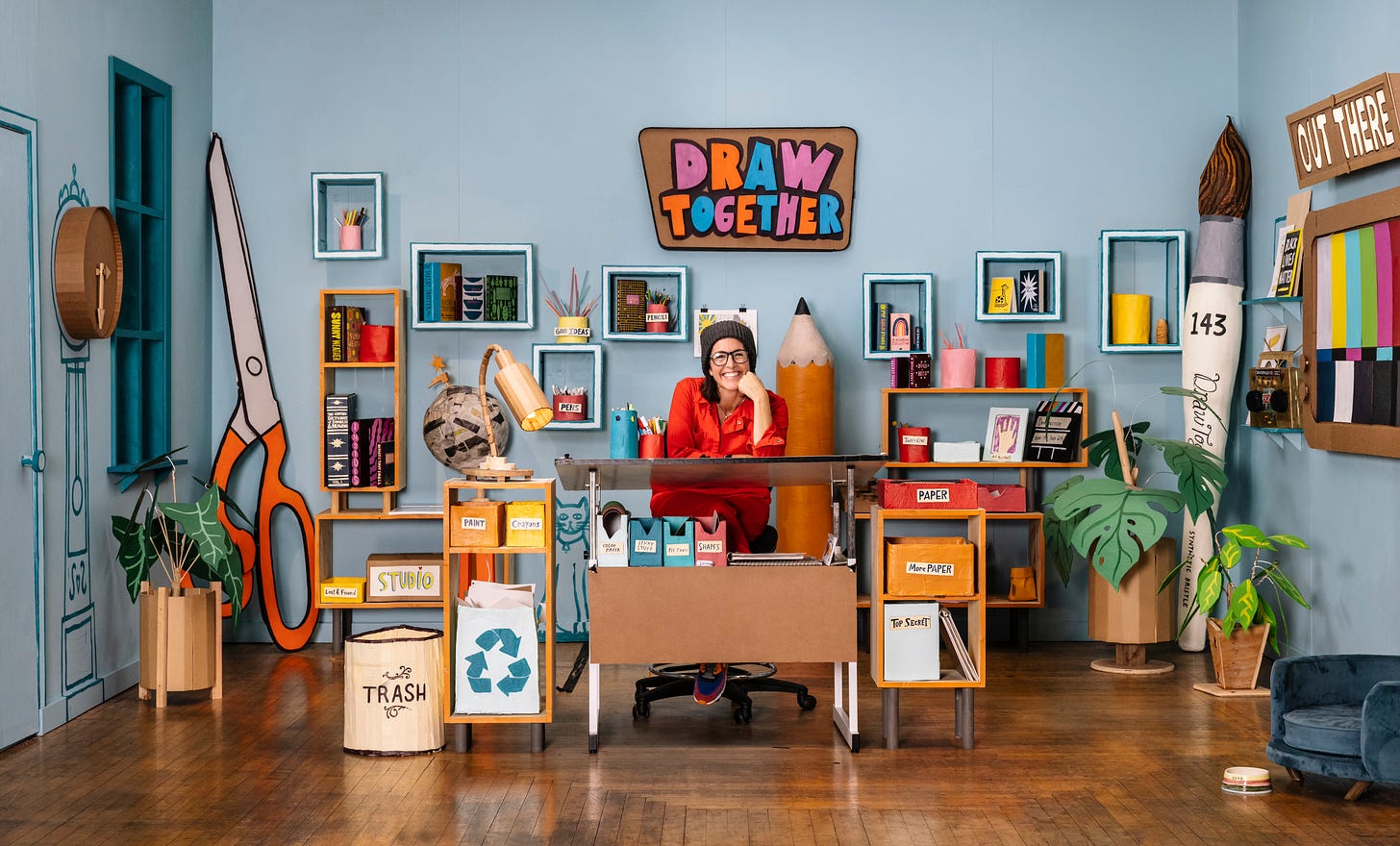
DrawTogether Classrooms has reached nearly 300,000 learners, and distributed thousands of high-quality art kits to Title 1 schools. We even partnered with NASA to create the first ever kids art show in space! If you know someone who would like to bring more art and heart into the classroom, send them to DrawTogether Classrooms, and get in touch with us at classrooms@drawtogether.studio
PS. It’s free. :)
Back to School continues
Last week’s assignment from artist Ali Liebegott struck a chord. Your binder paper drawings are wonderful, filled with such personal, vulnerable, inspiring, and hilarious lists and messages. Check them out if you haven’t already (and do one yourself!)
Today we build on that back-to-school nostalgia with a classic elementary art material: oil pastels. I loved them as a kid (maybe you did too?!) but eventually was drawn to other mediums (har har.) So when I learned about the therapeutic effects of this creamy crayon, I became curious. Maybe it’s worth trying them out again…
So today we’re going to learn about oil pastels and do some experimenting. If you don’t have any, you can pick up a set at any art supply or arts & crafts store. Sometimes you can find student grade ones in the school supply aisle of the drug store. Or just use some old lipstick, maybe? Turns out, it’s not that different.
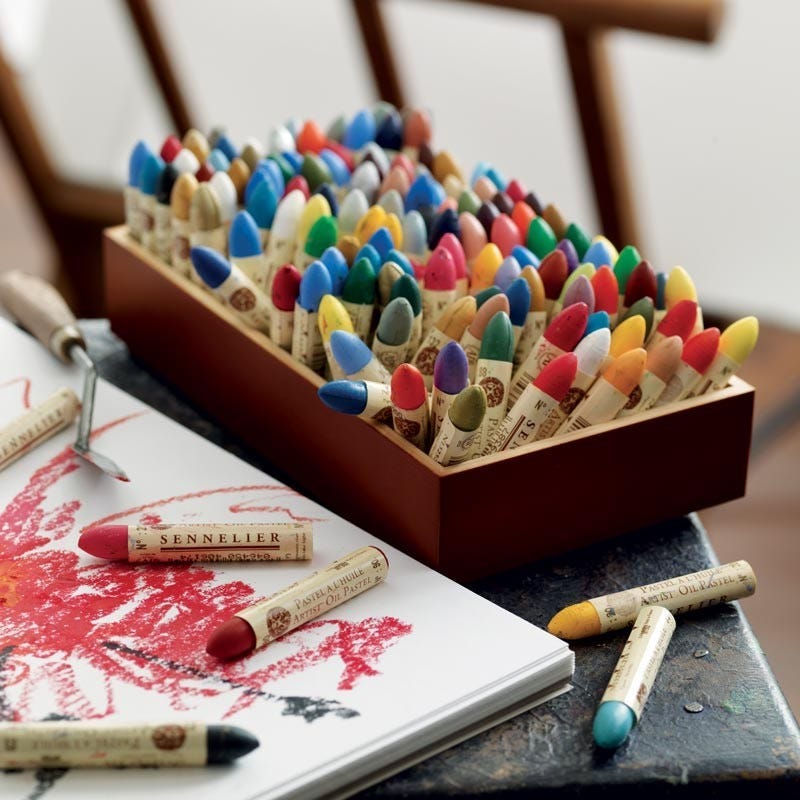
Oil Pastels: Cheaper than Therapy
While most of us were introduced to oil pastels as kids in the art room, oil pastels have long been a popular tool for art therapists working with stressed-out clients. And turns out, there’s science to back it up. In 2018, researchers studied people’s emotional response when they used three different drawing mediums: pencil, oil pastels, and gouache. People played with all three materials while listening to music and having their heart rate monitored. Results? Both oil pastels and gouache contributed to an “improved positive mood,” as opposed to the pencil.1
To get wonky and oil pastel specific: the researchers found that “the largest suppression of PNS [parasympathetic nerve system] and augmentation of the SNS [sympathetic nerve system] occurred during art-making with oil-pastels.” They suggested that “these findings might be explained by the enhanced tactile experience of art-making with oil-pastels along with their relative fluidity.”
Translation: Drawing with oil pastels is a fluid, tactile experience that feels good, and makes us feel better.
Therapist Cathy Malchiodi, PhD, referred to earlier studies on the value of oil pastels in a piece she published in Psychology Today: “In the field of art therapy, oil pastels have been associated with expression of emotion as well as control because they are generally easy to manipulate (Moon, 2010). In an earlier study, a significant number of participants indicated feelings of joy and excitement in anticipation of working with oil pastels (Snir & Regev, 2013).”
Translation #2: Want a mood boost? Grab some oil pastels and draw.
On top of the emotional impact of the medium, turns out oil pastels have a fascinating history. Our editor Candace (who also happens to have a PhD in history) did a deep dive on the subject. Hold onto your fixative, this is fascinating. Here’s Candace:
Candace’s Corner: Origins of Oil Pastels
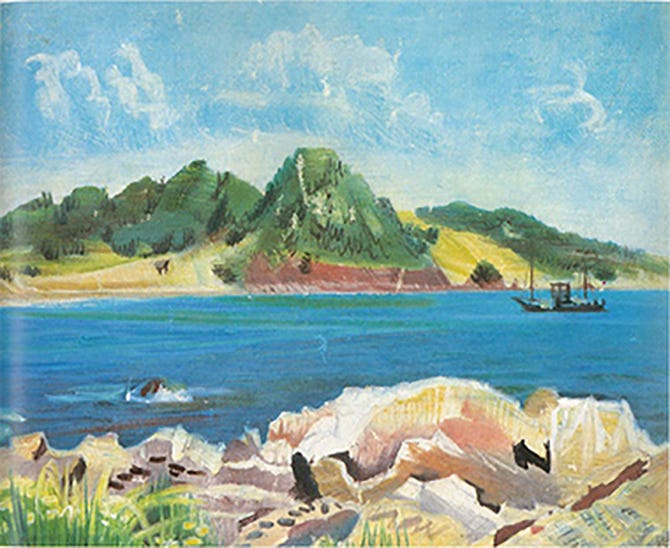
Hi everyone! I started off just wanting to learn about the creation of oil pastels, and I ended up completely engrossed by what I found: what we know as oil pastels began in Japan as part of a new approach to teaching art to children and encouraging their creativity.
Previously, art education in Japan emulated traditional models in the West that emphasized copying images in textbooks. Artist Yamamoto Kanae wanted to change that. He had been studying in Europe when World War I broke out, and he returned to Japan by going through Russia. In Moscow, he came across an exhibition of children’s paintings and was struck by the freedom he saw in their work. He wanted to bring out that creative spirit in Japanese children as well and become an advocate for developing avenues for their free artistic expression.

According to scholar Kingo Masuda, Yamamoto believed that, instead of copying, “children should be encouraged to draw what they wished, based on what they saw and felt.”2 Sounds like someone I know!
Yamamoto also thought children would benefit from a new drawing medium, something colorful and accessible. Teachers Rinzo Satake and Shoukou Sasaki joined forces with Yamamoto and created Cray Pas (a combo of the words crayon and pastel) with the Sakura company. While there are some conflicting dates of origin, the company is celebrating this year as the 100th birthday of the oil pastel.
Then as Wendy has written before, the oil pastel began to gain popularity with European artists as well. And when World War II created shortages of art materials, a peer of Pablo Picasso asked famed Parisian art store Sennelier to develop an artist-grade oil pastel for Picasso’s use: “[He wanted] a medium that could be used freely on a variety of surfaces without fading or cracking. Their collaboration produced the incomparable Sennelier oil pastels.”3
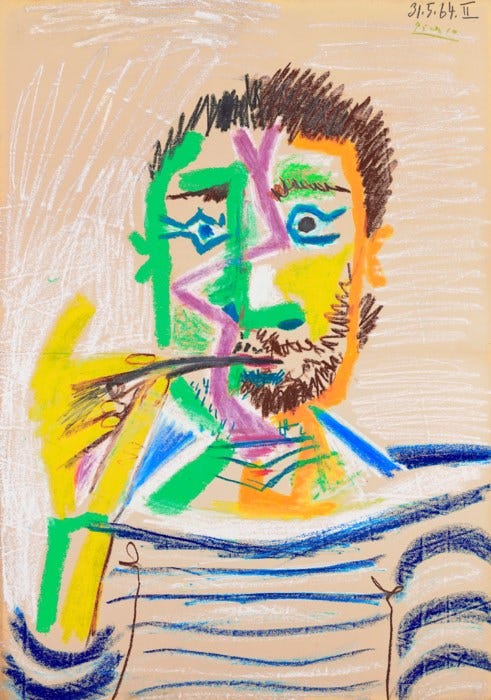
Today, CrayPas and Sennelier still dominate the market (CrayPas being a more student-grade oil pastel, and Sennelier more professional). In recent history, additional manufacturers have started creating their oil pastels, like Caran D’ache and Holbein. Every manufacturer’s oil pastels have different qualities. If you enjoy working with oil pastels, you may want to try a few different brands to see which works best for you and whatever you’re creating. (But maybe just a couple colors each — oil pastels can get pricey!) Which leads us to our next deep dive: how to use them.
Pastel Techniques: Tips and Tricks
Thanks, Candace! Now that you know the What, the Why, and the When/Where, let’s get to the fun stuff: The How.
I am no oil pastel pro, so we are learning this all together. Spoiler alert: IT’S FUN.
Let’s start with a fundamental attribute of oil pastels: they are oil based (duh) mixed with a wax binder. That means they do not dry. Like, ever. When you finish an oil pastel drawing you must frame it under glass or risk it smudging. And smudge it will. Fixatives may help fix your marks in place a bit, but no amount of fixative will ever protect it permanently. Only glass can do that.
The advantage of it being malleable and forever fudgable is all the ways to work with it. Things to do with oil pastels: smudge, scrape, blend, scratch, smack, screech, and do all sorts of other things, over and over, again and again. They are not an exact medium by any measure. While you can use an exacto to shave an edge onto some of the firmer brands, they still make more of a moosh than a slice.
Drawing, layering and blending with oil pastels feels more like finger painting than drawing like you do with color pencils or or pens or even watercolors. It’s a very messy, tactile experience. They are opaque. Draw lightly, and they coast along the surface and reveal the paper’s texture: vellum or hot press watercolor or even newsprint offers a smooth surface, and produces a smooth line. A cold press, or canvas or pastel paper will give you some grain or pattern, like the oil pastel I used on rough charcoal paper above.
I was interested in how different oil pastels offered different drawing experiences and results, so I went to the art store and got a few different brands to play around with. This will be OUR scientific study, Grown-Ups table. (And art supply review.)
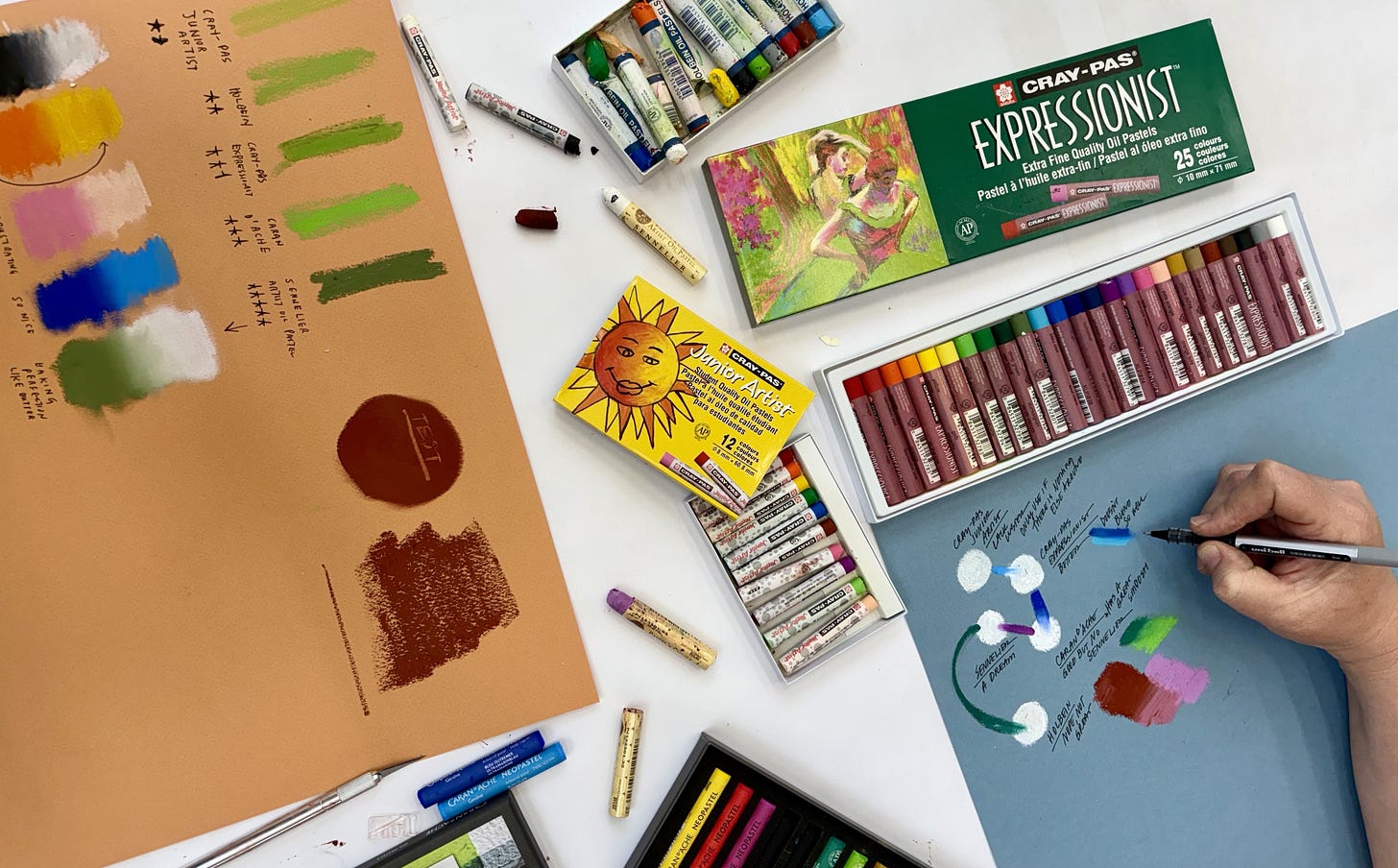
The five brands we tested: Cray-Pas: Junior Artist, Holbein Academic, Cray-Pas: Expressionist, Caran D’Ache, Sennelier
Here is a big ol sheet of colored pastel paper where I put each brand through a battery of tests: basic line drawing, smudging, blending, precise lines, dots, and drawing on its side. I also just included some layering and scraping for fun, mostly so you can see the technique. Click to zoom in!
Here is our review of each brand:
Cray-Pas: Junior Artist.
PRO: A great intro if you are new to oil pastels and/or want to mess around with something without worrying about getting it right. A friend told me she keeps a box at home. When she wants to get some feelings out onto paper, she draws big block letters and fills them in with the Cray-Pas Junior.
CON: They are not very smooshy. They kind of drag, more like drawing with old soap than smooth butter. Work hard enough and smudging will tear the paper.
Holbein Academic Oil Pastels.
PRO: They feel pretty smooth, and are a great entry point for someone who has never worked with oil pastels before and wants to keep the box under ten bucks. This is the student grade, so they are pretty similar to the Cray-Pas Junior.
CON: While they have more coverage than the Cray-Pas Junior, I don’t recommend smudging them. And blending? Don’t get me started. Maybe I was doing it wrong, or a different paper would’ve yielded a better result, but they didn’t work for me.
Cray-Pas: Expressionist.
PRO: Better! more coverage. Makes a good line and dot!
CON: Still doesn’t blend so well. Drags more than blends, but better than the first two.
Caran D’Ache.
PRO: Alright, now we’re cooking! Great coverage, vibrant color, and way smoother than the aforementioned sets. Layers well. Blending is a breeze! SMOOSHY!
CON: Needs a lot to get to full opacity. I wouldn’t have known that it could better if I hadn’t tried the last and final oil pastel:
Sennelier.
PRO: Honestly, this may be made of french butter and natural pigments. (Tempting, but do not eat!) These oil pastels feel SO good to use — their fluid ease and total coverage makes drawing with them a treat. The luxury car of oil pastels. All of them will get you there, but this one is a joy to drive.
CON: Hard to make a sharp line because of the smooshiness. But who cares. SMOOSH AWAY.
That’s it. So curious to hear what you think as you try one or more kinds of oil pastels. Which brings us to our assignment.
This week we are experimenting with three techniques you can do with any type of oil pastels, including lipstick. 😘



